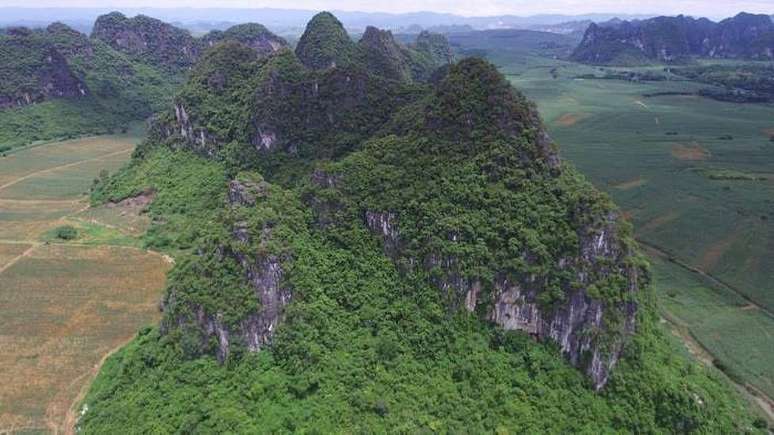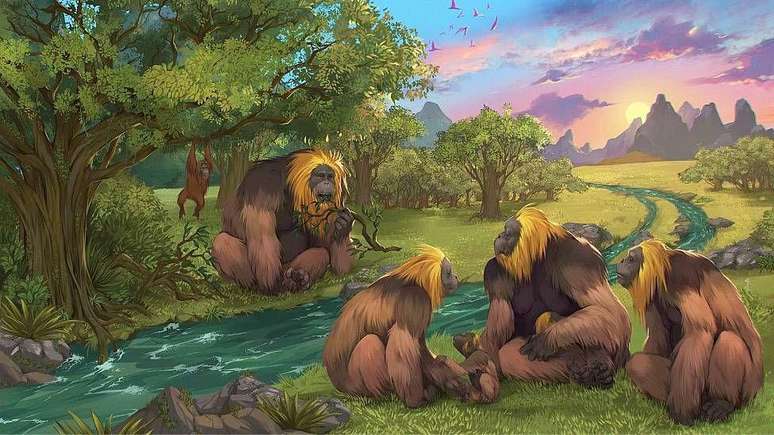It measured about three meters and weighed about 250 kilos. How is it possible that such a powerful primate became extinct? A new study clears up the mystery.
It was the largest primate on the planet and its extinction remained a mystery for decades.
The monkey Gigantopithcus blacki or Gigantopithecus was about three meters tall and weighed about 250 kilograms.
This primate lived on the plains of southern China and became extinct shortly before the arrival of man in that region.
The only remaining traces of this species’ existence are around 2,000 fossilized teeth and four jaws.
A new study conducted by Chinese, Australian and American researchers published in the journal Nature demonstrates for the first time not only that Gigantopithecus became extinct between 295,000 and 215,000 years ago, but also what the reasons for its disappearance were.
Teeth, pollen and sediment
“The story of G. blacki is an enigma in paleontology: how could such a powerful creature become extinct in an era when other primates adapted and survived? The unsolved cause of its disappearance has become the ‘Holy Grail’ of this discipline “, says paleontologist and study co-author Yingqi Zhang, of the Institute of Vertebrate Paleontology and Paleoanthropology of the Chinese Academy of Sciences (IVPP).
“IVPP has been digging up evidence of G. blacki in this region for more than 10 years. But without solid dating and consistent environmental analysis, the cause of its extinction is uncertain.”
The researchers collected evidence from 22 caves spread across a large region in southern China’s Guangxi province.
Key to the study was the use of multiple dating techniques.
Using detailed pollen analyses, faunal reconstructions, stable isotope analyzes of teeth, and detailed analyzes of cave sediments, the team also established the environmental conditions that led to the extinction of Gigantopithecus.
“Teeth provide incredible information about species behavior, indicating stress, diversity of food sources and repeated behaviors,” explains Renaud Joannes-Boyau, a professor at Southern Cross University in Australia and another of the study’s authors.
The results show that Gigantopithecus became extinct much earlier than previously assumed.
And that its disappearance was due to changes in climatic and environmental conditions.

A giant who failed to adapt
Before these changes, “the predominant vegetation in the territory inhabited by Gigantopithecus was made up of tree species from the Pinaceae (fir, cedar and pine), Fagaceae (chestnut, beech and oak) and Betulaceae (birch, alder and hazel) families”, he explains Paul Palmqvist Barrena, professor of paleontology at the University of Malaga, in an article about the study on the website The Conversation.
“In the period immediately preceding the extinction of Gigantopithecus, this vegetation was replaced by tree species typical of a more open environment, giving way to a clear predominance of ferns and pastures.”
“There is also an increase in carbon in the sediments, which suggests an increase in the frequency of forest fires. All this indicates a profound change in the ecosystem, marked by progressive aridification and a more seasonal climate,” explains Palmqvist.
The study established that another species, orangutans (of the genus Pongo), a close relative of Gigantopithecus, was able to adapt its size, behavior and habitat preferences to changing conditions.
But Gigantopithecus became dependent on a less nutritious food source when its preferences were unavailable, which reduced the diversity of its foods. The giant primate became less mobile, had a reduced geographic range to forage for food, and faced chronic stress.
“G. blacki was the specialist par excellence, compared to more agile adapters such as orangutans, and this eventually led to its demise,” says Professor Zhang.

Professor Palmqvist Barrena points out that, due to greater environmental variability and climatic seasonality, Gigantopithecus “would have been forced to consume a smaller variety of plant products which, moreover, provided less nutritional value, as demonstrated by the analysis of growth intervals in the enamel of fossil teeth, more marked”.
Such conditions would have been less stressful for the orangutan, as it is a smaller and less specialized species than Gigantopithecus.
“Instead, Gigantopithecus’ bulky body, lower mobility, and longer generation turnover times likely sealed its fate,” says Palmqvist Barrena.
The new study not only clarifies what happened in the past, but is important for indicating the future, explains Kira Westaway, a geochronologist at Macquarie University, Australia, and another of the authors of the work.
“With the threat of a sixth mass extinction looming over us, there is an urgent need to understand why species go extinct,” the scientist said.
“Exploring the reasons for past unresolved extinctions gives us a good starting point for understanding the resilience of primates and the fate of other large animals, past and future.”
Source: Terra
Rose James is a Gossipify movie and series reviewer known for her in-depth analysis and unique perspective on the latest releases. With a background in film studies, she provides engaging and informative reviews, and keeps readers up to date with industry trends and emerging talents.


![New York Special: Why You Won’t See It Anymore [Spoiler] in the series? New York Special: Why You Won’t See It Anymore [Spoiler] in the series?](https://fr.web.img6.acsta.net/img/fc/a2/fca242c7befc75467758596593c0656d.jpg)





